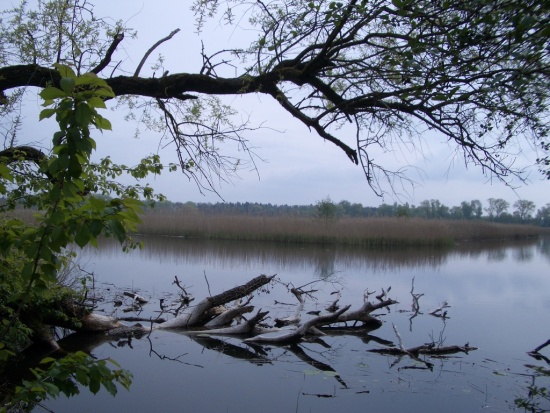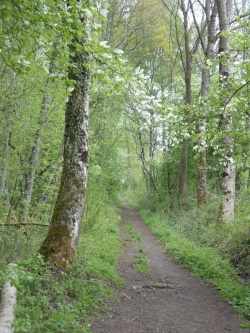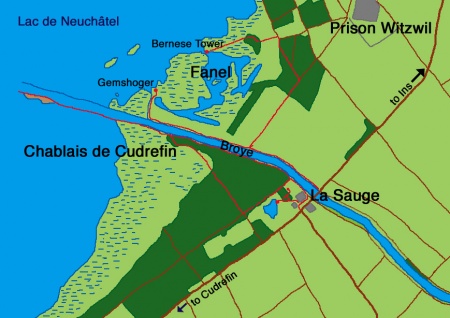
Overview
The vast Lake Neuchatel in western Switzerland is one of the most important ornithological areas in the country and holds large numbers of diving ducks in winter. Part of the lake is a Ramsar site and there are several nature reserves, but much of the shoreline is built up.
One of the best areas for birders is the Fanel Nature Reserve and neighbouring Chablais de Cudrefin in the northeastern corner of the lake. Here the shore has marshes and reedbeds, islands and sandbanks, and an area of deciduous woodland. Wintering waterfowl are of great interest here but there is also an excellent range of breeding birds and a wide variety of birds on passage including many rarities.
Just outside the Fanel - Chablais de Cudrefin lies the Grosses Moos which offers also good birding, especially during migration.
Birds
Notable Species

The reserve is good all year around, except in cold winters, when the lagoon freezes.
Wintering waterfowl like Whooper Swan, Bean Goose, Greylag Goose, Eurasian Wigeon, Northern Pintail, Northern Shoveler, Red-crested Pochard, Common Pochard and Tufted Duck are found easily. Usually some Common Eider, Red-breasted Merganser and sometimes Smew are around as well. Occasionally Red-throated Diver can be seen from the outmost tip of the dam. Great Grey Shrike can be found in the Chablais de Cudrefin. Dozens of Great Egret and some Great Bittern. Merlin can be found as well.
In spring you may find less waterfowl, but many different species of Waders, Egrets, Warblers, Terns and Gulls. Anything can be possible. March and April are good for woodpeckers (eg Lesser Spotted Woodpecker and Grey-headed Woodpecker). In April and May Great Reed Warbler and Savi's Warbler are arriving and are easy to see. The numbers of Waders differ according to the water level and the weather.
In summer, it's much quieter. Breeding birds, including Red-crested Pochard, Yellow-legged Gull, Great Cormorant and Common Tern are around and the reedbeds host Little Bittern and Purple Heron, Bearded Tit, and Savi's, Sedge, Reed and Great Reed Warblers. In the nearby woodlands, Black Kite, Grey-headed Woodpecker and Crested Tit nest. (see Grosses Moos (Switzerland)
Autumn is similar as spring, but in recent years better for waders (more sand banks). The third route allows you to reach the Bernese Tower, which is only open for members of the Berner Ala. You follow the Canal on the right side and turn right at the first crossing. Turn left again in the wood and you reach a small house. Go up to the enbankement and left again. Soon you will reach the tower. It allows good views over the colony of Common Tern and the reedbeeds with breeding Purple Heron
Rarities

Some rarities in the last years: Western Cattle Egret, Squacco Heron, Greater Flamingo, Collared Pratincole, Broad-billed Sandpiper, White-rumped Sandpiper, Pectoral Sandpiper, Great Skua, Gull-billed Tern, Slender-billed Gull, Aquatic Warbler and Collared Flycatcher.
Check-list
Birds you can see here include:
Red-throated Diver, Arctic Loon, Little Grebe, Great Crested Grebe, Black-necked Grebe, Great Cormorant, Great Bittern, Little Bittern, Black-crowned Night Heron, Little Egret, Great Egret, Grey Heron, Purple Heron, White Stork, Black Stork, Mute Swan, Whooper Swan, Bean Goose, Greater White-fronted Goose, Greylag Goose, Common Shelduck, Eurasian Wigeon, Gadwall, Common Teal, Mallard, Northern Pintail, Garganey, Northern Shoveler, Red-crested Pochard, Common Pochard, Ferruginous Pochard, Tufted Duck, Greater Scaup, Common Eider, (rare in Su), Long-tailed Duck, Common Scoter, Velvet Scoter, Common Goldeneye, Smew, Red-breasted Merganser, Common Merganser, European Honey Buzzard, Black Kite, Western Marsh Harrier, Hen Harrier, Eurasian Goshawk, Eurasian Sparrowhawk, Common Buzzard, Osprey, Common Kestrel, Merlin, Eurasian Hobby, Peregrine Falcon, Water Rail, Spotted Crake, Little Crake, Common Moorhen, Eurasian Coot, Eurasian Oystercatcher, Black-winged Stilt, Pied Avocet, Little Ringed Plover, Ringed Plover, Kentish Plover, Eurasian Golden Plover, Grey Plover, Northern Lapwing, Little Stint, Temminck's Stint, Dunlin, Ruff, Common Snipe, Eurasian Woodcock, Black-tailed Godwit, Bar-tailed Godwit, Whimbrel, Eurasian Curlew, Common Redshank, Common Greenshank, Green Sandpiper, Wood Sandpiper, Common Sandpiper, Ruddy Turnstone, Mediterranean Gull, (scarce in Su), Little Gull, Black-headed Gull, Common Gull, Lesser Black-backed Gull, Yellow-legged Gull, Common Tern, Whiskered Tern, Black Tern, White-winged Black Tern, European Turtle Dove, Common Cuckoo, Common Kingfisher, Eurasian Hoopoe, Eurasian Wryneck, Grey-headed Woodpecker, Lesser Spotted Woodpecker, Sand Martin, Barn Swallow, Western House Martin, Meadow Pipit, Water Pipit, Yellow Wagtail, Grey Wagtail, Common Nightingale, Bluethroat, Whinchat, European Stonechat, Savi's Warbler, Common Grasshopper Warbler, Sedge Warbler, Common Reed Warbler, Great Reed Warbler, Lesser Whitethroat, Common Whitethroat, Bonelli's Warbler, Common Chiffchaff, Willow Warbler, Goldcrest, Common Firecrest, Spotted Flycatcher, European Pied Flycatcher, Bearded Parrotbill, Long-tailed Tit, Crested Tit, Eurasian Penduline Tit, Eurasian Golden Oriole, Red-backed Shrike, Great Grey Shrike, Rook, Chaffinch, European Greenfinch, European Goldfinch, Ortolan Bunting (mainly Sp), Reed Bunting
Other Wildlife
The rare and restricted European Beaver Castor fiber can sometimes be seen at Fanel, other mammals include Red Fox Vulpes vulpes, Wild Boar Sus scrofa, and deer.
Site Information
History and Use

The area was once under water, but after a great river correction in the 19th century, it fell dry. It was first used as a waste area, but later protected as a bird sanctuary.
It's a popular place and the dam can be crowded on sunny days. Most people are aware of the rules and don't disturb the birds. If you see them do otherwise tell them! The area is also very popular among Swiss birders and you may meet someone on almost every day of the year.
Areas of Interest
The most popular route starts at the Nature Centre La Sauge. Go to the Broye canal and turn left, following the canal to the lake. On the canal Red-breasted Merganser and Common Kingfisher can be seen. To your left is woodland, holding Eurasian Golden Oriole, Common Nightingale, Grey-headed Woodpecker and Short-toed Treecreeper. After about 20 minutes you reach the embankement. On the left are sometimes big sand banks, holding an interesting range of waders. On the right you can see the two artifical islands, holding waders as well and a big colony of Cormorants and Yellow-legged Gull. Look out for Ducks, Gulls and Terns. It's worth to spend several hours here. On the way back you can take the first path to the right, which leads you through the Chablais de Cudrefin. Follow this path until a crossing, where you go left and you reach La Sauge again.
Another route goes out along the Broye Canal on the other side. Follow the canal until you have to go right and you will reach a small hillock with a hide, called Gemshoger. From here you have an excellent view over the two islands and good chances for Great Reed Warbler, Savi's Warbler, Bearded Parrotbill (Bearded Tit) and Purple Heron. The nearby tower is only accessible for members of Nos Oiseaux. Go back the same way you came.
The third route allows you to reach the Bernese Tower, which is only open for members of the Berner Ala. You follow the Canal on the right side and turn right at the first crossing. Turn left again in the wood and you reach a small house. Go up to the enbankement and left again. Soon you will reach the tower. It allows good views over the colony of Common Tern and the reedbeeds with breeding Purple Heron
The Centre nature La Sauge is also worth a visit, open daily in summer except Mondays. There is an interesting exhibition and three hides. One is excellent for Common Kingfisher, the other for waders, although it can be quite birdless sometimes.
Access and Facilities

The next train station is at Ins. Every half hour trains from Berne or Neuchatel stop there. It's possible to hire bicycles there (reservations phone 032 313 15 29). With a bicycle you can reach the reserve in 30 minutes and you can see additional species on the way. (See Grosses Moos)
In summer La Sauge can be reached by ship on the route Neuchatel - Murten.
With the car from Ins follow the road to Witzwil / Cudrefin. If coming from Neuchatel turn right in Gampelen to Cudrefin. The road crosses the Broye Canal and before the canal on the left you will find a car-park. Another car-park is just after the bridge at La Sauge, but it's sometimes difficult to find space here, especially on weekend.
At la Sauge you can also book rooms (for up to four people). Otherwise the area holds some campsites and hotel accommodation is plentiful in local towns and villages.
Contact Details
SVS-Naturschutzzentrum La Sauge
1588 Cudrefin
Tel. 026 677 03 77
Fax 026 677 03 87
lasauge@birdlife.ch
External Links
- Swiss Railway timetable
- Timetables of ships on the three lakes
- Accomodation at La Sauge
- Informations about the nature centre
- Latest sightings in Switzerland
- Rarities
- Fanel - Chablais de Cudrefin on Google Maps
As the Fanel / Chablais de Cudrefin is often visitied by birders you can get recent informations about the birds seen on this last two websites. Chablais de Cudrefin is often abbreviated CdC.
Content originally posted by Steve, edited and updated by Wintibird



